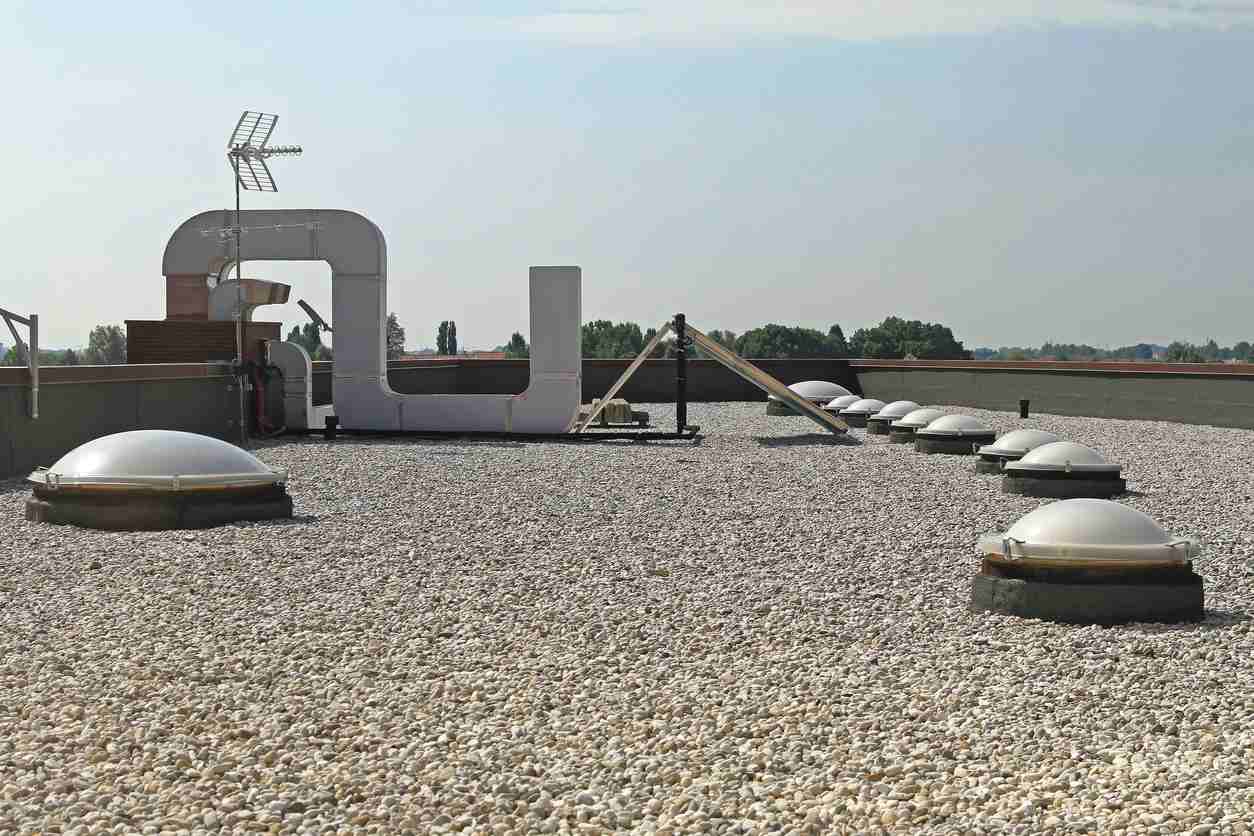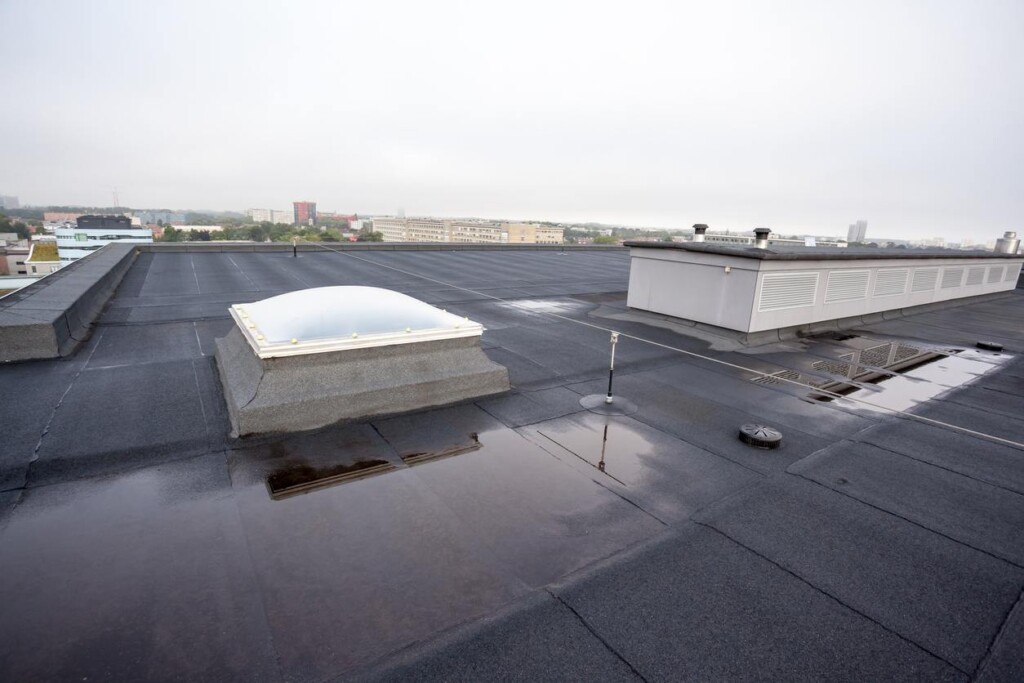
Built-up roofing, or just BUR, is a favorite for flat or low-slope roofs, especially on commercial buildings. But what is a built-up roof exactly, and what’s involved in its application?
A BUR roofing system combines layers or “plies” of felt or fabric, bitumen, and a protective gravel or mineral material coating. Together, these layers create a strong, weather-resistant roofing surface.
How Built-Up Roofing Is Made
To better understand what a built-up roof is, it’s worth knowing how it’s made. BUR construction stacks layers of roofing material, reinforcing the roof’s durability. The process starts with applying a layer of felt, a flexible material often made from fiberglass or organic mats, which provides a solid base.
Next is the bitumen layer—a thick, black crude oil byproduct applied between each felt layer. Heated and spread, it forms a tough, waterproof barrier that binds the roofing layers securely. Often used for road construction, bitumen adds durability, helping the roof withstand harsh conditions.
Once the waterproof layers are set, installers spread a final coat of gravel or mineral granules across the surface, using rakes or special spreaders to get an even layer. The layer shields against UV rays that wear down materials. These layers form a leak-resistant roof ready to withstand 20 to 30 years of weathering.
Advantages of Built-Up Roofing
BUR has remained a top choice in the roofing industry for several reasons. Let’s break down some of its biggest benefits:
- Waterproofing: BUR’s bitumen layers are powerful water barriers that prevent leaks and water damage, even on large, flat roofs where water can pool.
- Durability: Thanks to its multi-layered construction, BUR can withstand heavy foot traffic, making it suitable for buildings that require rooftop access for maintenance or other purposes.
- UV protection: The gravel or mineral top layer isn’t just for show—it reflects sunlight, reducing UV damage that can wear down other roofing types. It also helps regulate building temperatures, potentially lowering cooling costs.
- Fire resistance: Many BUR systems have fire-resistant properties, a vital feature for commercial buildings, as some types of bitumen and protective topcoats are designed to resist flames.
These benefits make BUR a top choice for businesses looking for a long-lasting, low-maintenance roofing solution built to withstand the elements.
Potential Concerns with Built-Up Roofing
While built-up roofing is robust and reliable, it does come with certain considerations to keep in mind:
- Weight: Built-up roofs can be relatively heavy due to the multiple layers. This means that the building structure needs to support the added weight, which may not be suitable for all buildings, especially older or lightly constructed ones.
- Installation complexity: Installing BUR is labor-intensive and requires skilled professionals. The process involves heating bitumen and meticulously applying each layer, which adds to the installation time and cost.
- Odor during installation: Bitumen produces a noticeable odor when heated, which can be inconvenient, particularly in densely populated areas. Although the smell dissipates after installation, it can be a factor to consider for buildings close to neighboring structures.
- Maintenance needs: BUR roofs, while durable, still require periodic maintenance to remain in optimal condition. Roofers recommend regular inspections to check for cracks or wear in the bitumen layers, with minor repairs helping to prevent significant damage. Proper maintenance can extend the life of a BUR roof, but it’s an ongoing commitment.
These potential concerns don’t necessarily outweigh the benefits of BUR, but they are essential factors to consider when deciding if it’s the right fit for a building’s roofing needs.
Comparing Built-Up Roofing with Alternative Systems
When considering roofing options, consider how BUR stacks up against other choices like single-ply membranes or modified bitumen roofing:
- Single-ply membranes: Lightweight and easier to install, single-ply membranes are often used for flat roofs. However, they may not offer the same level of durability as BUR, especially in high-traffic areas.
- Modified bitumen: Like BUR, modified bitumen roofing provides flexibility and durability, especially in areas with temperature extremes. However, it generally lacks the multi-layered resilience of a BUR system, which can mean a shorter lifespan in challenging environments.
The durability and waterproofing of BUR often make it a preferred choice, particularly for commercial buildings where long-term investment in a reliable roof is essential.
What Is a Built-Up Roof’s Ideal Application and Suitability?

BUR is commonly used in commercial buildings like offices, shopping centers, warehouses, and manufacturing plants. However, it’s quite common in residential buildings, too. Most high-rise apartments have flat rooftops that are often used as recreational spaces. BUR provides a sturdy surface that handles foot traffic, outdoor furniture, building equipment, and other items.
Large flat roofs often pool water, especially with poor drainage. BUR’s many layers keep water from seeping through the roof, preventing leaks and costly property damage. Its UV-reflective gravel top layer makes it ideal for extreme climates, withstanding heavy rain, snow, and intense sun. BUR’s slip-resistant surface also works well for buildings needing rooftop access for maintenance.
Get Expert Advice on Built-Up Roofing
You now know what a built-up roof is, but is the right fit for your building? The answer depends on several factors, including the building’s structure, location, and expected usage. To find out if a BUR system meets your needs, contact American Roofing Company. Our team of expert roofers can assess your building and provide recommendations best suited to your situation.
Start by requesting a free quote from American Roofing today, and take the first step toward a roof built to last.
